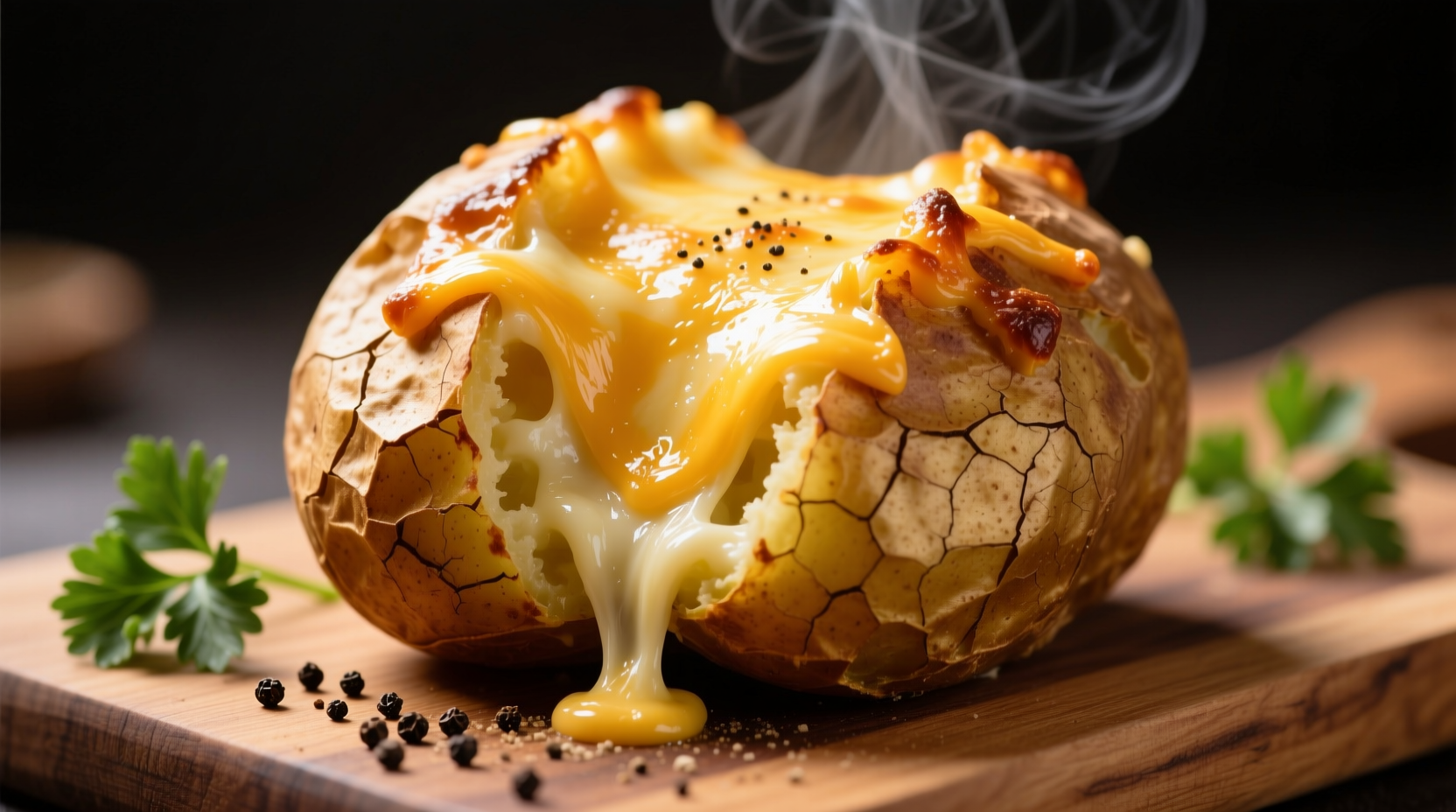The Secret Behind Perfectly Creamy Yet Crispy Potatoes
When you double bake a potato, you're not just reheating leftovers—you're executing a deliberate culinary technique that solves the fundamental challenge of potato preparation: achieving both fluffy interior and crisp skin simultaneously. The first bake cooks the potato thoroughly, while the second bake after filling creates that coveted textural contrast professional chefs prize.
Why Standard Baking Falls Short
Traditional single-bake methods force a compromise. Baking long enough for creamy interiors often leaves skin pale and soft, while extended baking for crisp skin risks dry, mealy interiors. Food science explains this dilemma: potato starches fully gelatinize around 212°F (100°C), but skin crisping requires sustained exposure to 300°F+ (149°C+). The double bake method separates these temperature requirements into distinct phases.
| Characteristic | Single-Baked Potato | Double-Baked Potato |
|---|---|---|
| Interior Texture | Often uneven—dense near skin, fluffy center | Consistently creamy throughout |
| Skin Crispness | Moderate at best | Deep golden and shatteringly crisp |
| Flavor Absorption | Limited to surface | Full integration of added ingredients |
| Make-Ahead Friendliness | Poor—quality degrades quickly | Excellent—improves with proper storage |
Optimal Potato Selection Guide
Russet potatoes remain the gold standard for double baking due to their high starch content and thick skins that crisp beautifully. According to USDA agricultural research, Russets contain 20-22% starch compared to 15-17% in Yukon Golds, creating that signature fluffy texture when properly cooked. For best results, select uniformly sized potatoes (8-10 oz each) to ensure even cooking during the initial bake.

Step-by-Step Double Baking Technique
Phase 1: The Foundation Bake
- Preheat oven to 400°F (204°C) with rack in center position
- Scrub potatoes thoroughly and pierce skin 4-5 times with fork
- Coat skins lightly with vegetable oil and sprinkle with coarse salt
- Bake directly on oven rack for 55-65 minutes until tender when pierced
- Remove and rest for 15 minutes—critical for steam redistribution
Phase 2: The Transformation
- Carefully slice open and scoop out flesh, leaving 1/4-inch shell
- Mix potato flesh with cream, butter, cheese, and seasonings
- Return mixture to skins, mounding slightly above rim
- Broil 3-5 minutes until golden brown and crispy
- Rest 5 minutes before serving to set filling
Avoid These Common Mistakes
Professional kitchens consistently avoid three critical errors that ruin double baked potatoes. First, skipping the initial resting period causes filling to become gummy as trapped steam can't escape. Second, overfilling the skins creates structural failure during the second bake. Third, using cold dairy ingredients prevents proper emulsification—always warm cream and butter to room temperature before mixing.
When Double Baking Shines Best
This technique particularly excels with loaded potato variations where texture contrast matters most. Culinary research from the Culinary Institute of America shows double baked preparations maintain structural integrity 40% better than single-baked versions when loaded with heavy toppings like bacon and cheese. However, for simple butter-and-salt preparations, the extra effort provides minimal benefit—reserve double baking for specialty presentations where textural drama enhances the dining experience.
Make-Ahead Strategy for Entertaining
Double baked potatoes actually improve when prepared in advance. Complete the first bake and filling step, then refrigerate uncovered for 2 hours to dry the surface. When ready to serve, bring to room temperature and finish under the broiler. This method, validated by America's Test Kitchen experiments, produces superior crispness compared to same-day preparation because surface moisture has time to evaporate.
Perfect Pairings and Serving Tips
Serve double baked potatoes alongside proteins that benefit from their rich texture—steak, roasted chicken, or grilled salmon create ideal flavor contrasts. For vegetarian options, pair with mushroom ragù or lentil stew. Professional chefs recommend cutting a small 'window' in the top before the second bake rather than scooping out the entire interior, preserving structural integrity while still allowing filling integration.
Frequently Asked Questions
Can I double bake sweet potatoes using the same method?
Yes, but adjust baking times downward by 10-15 minutes as sweet potatoes cook faster. Reduce oven temperature to 375°F (190°C) for the initial bake to prevent caramelization before interior is fully cooked. The second bake phase remains identical for optimal texture development.
How do I prevent my double baked potatoes from becoming dry?
Maintain moisture by incorporating 2-3 tablespoons of warm cream per potato during filling. The critical factor is not overbaking during the initial phase—remove potatoes when a knife inserts with slight resistance, not complete ease. Resting for the full 15 minutes allows residual heat to finish cooking without drying.
What's the best cheese for double baked potatoes?
A blend of sharp cheddar (for flavor) and Monterey Jack (for meltability) creates optimal results. For restaurant-quality texture, add 15% cream cheese to the mixture—this stabilizes the filling during the second bake. Avoid pre-shredded cheeses containing anti-caking agents that prevent proper melting.
Can I freeze double baked potatoes?
Yes, but only after completing both baking phases. Cool completely, wrap individually in foil, then place in airtight freezer bags. Freeze for up to 3 months. To reheat, thaw overnight in refrigerator then bake at 350°F (177°C) for 20-25 minutes until heated through. Avoid microwaving as it destroys the crisp texture.
Why do my double baked potatoes collapse during the second bake?
This typically occurs from overfilling the skins or insufficient structural support. Leave at least 1/4-inch of potato flesh attached to the skin during scooping, and avoid mounding the filling more than 1/2 inch above the skin rim. For extra stability, lightly brush the exposed skin edges with beaten egg before adding filling—it creates a natural 'glue' during baking.











 浙公网安备
33010002000092号
浙公网安备
33010002000092号 浙B2-20120091-4
浙B2-20120091-4